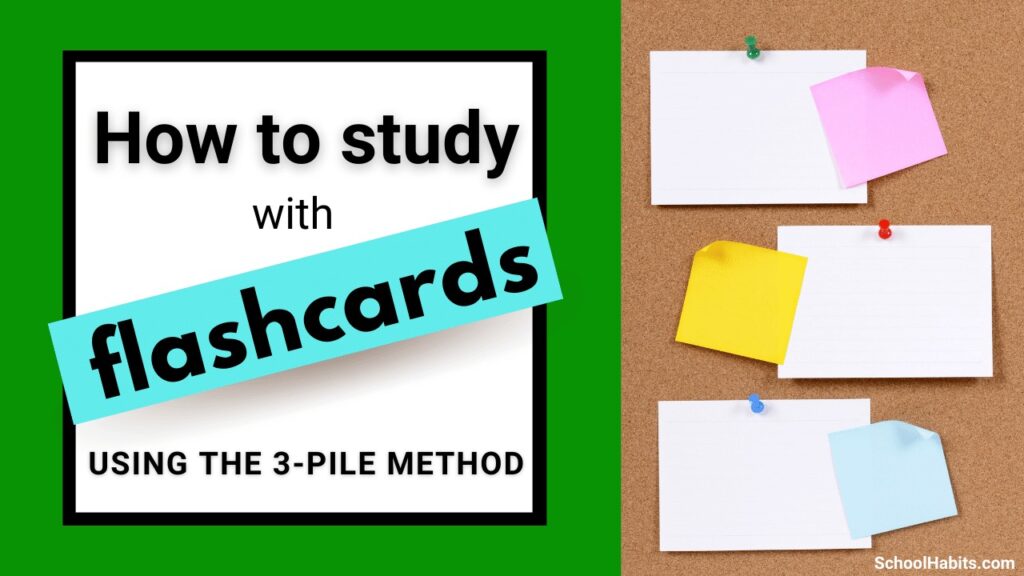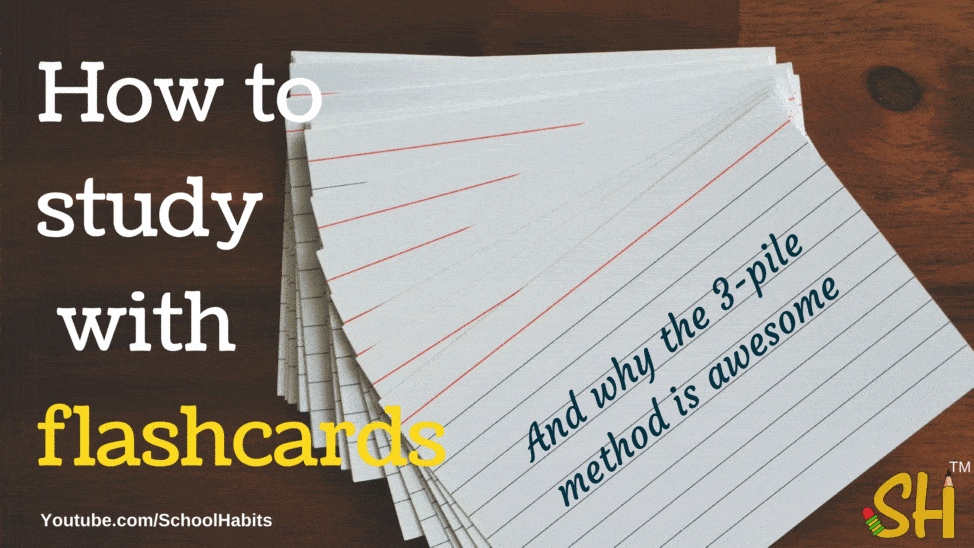
By Katie Azevedo, M.Ed.
Flashcards are probably one of the most commonly used study tools. Whether you use paper index cards or a digital version like Quizlet, flashcards are an excellent way to not only study new material but to learn it.
But knowing how to study with flashcards is key – because using flashcards to study involves way more than just flipping a card over to see what’s on the other side. To really benefit from all that flashcards have to offer, I suggest using what I’m naming the 3-pile method.
Before I explain the 3-pile method is, let’s talk a second about what to put on flashcards to begin with. The short answer: Anything!
The most common use for flashcards is to study vocabulary words (word on one side; definition on the other). But they can be used for so much more than vocabulary. Here are some ideas:
- Important people: Name on one side, what they did on the other side
- Key events: Event name on one side, significance/details on the other side
- Time periods: Dates or Era name (Renaissance, Golden Age, etc.) on one side, significance/details on the other side
- Math formulas: Formula name, formula written out/when to use it
- Diagrams: Diagram drawn out, significance/details
- Characters: character name, significance/details
- If you want to take your flashcard game to the next level, use them this way
Obviously, if you get creative, you can make flashcards to study nearly anything. Keep in mind that the process of making the flashcards, especially if you write them out by hand, is actually a form of studying. Here’s more about that.
How to make flashcards to study with
I don’t need to go into detail here because I’m sure you all know how to make flashcards. But my word of advice is to make the process as interesting and enjoyable as possible. This might mean getting new pens, fancy colored index cards, or washi tape. Whatever floats your boat. Go nuts. Or not. Again, whatever floats your boat.
How to study with flashcards, using the 3-pile method
Once you make your flashcards, it’s time to use them! Find someplace comfortable (but not too comfortable or you’ll fall asleep — here are 4 ideas for cool places to study) and get started. The 3-pile method is all about the concept of focusing first on what you partly know, and then last on what you don’t yet know. I explain below.
Here are the steps of the 3-pile flashcard method:
1. Go through the entire pile of flashcards, quizzing yourself on each one.
2. If you totally know the information (without having to turn the card over), put the card in a YES pile.
3. If you don’t know the information, put the card in a NO pile.
4. If you sort of know the information but have to turn the card over to confirm, put the card in a MAYBE pile. Be honest: If you look at side A and think “I used to know that one!” or “Shoot, I know it but I just forgot it!” — or if you flip to side B and say “Oh yeah, I knew that!” then put the card in the MAYBE pile.
5. Move the YES pile to the side. Move the NO pile to the side (but not too far away).
6. Pick up the MAYBE pile and start with those flashcards first. These flashcards contain information that you already sort of know. This means that the information is already partly familiar to you and partly recognizable by your brain. This information will take the least amount of effort and time to learn completely, because you’re already halfway there.
7. Go through all the cards in the MAYBE pile, adding cards to the YES pile as you learn them. If you don’t know a card, put it back in the MAYBE pile and keep going back to it until you know it.
8. Eventually all your MAYBE cards will end up in the YES pile.
9. Tackle the NO pile. These cards will be the most difficult to work through, because the information is likely totally unfamiliar to you. Work your way through this NO pile until you know them all. As you learn each card, add it to your YES pile.

Optional step
Whenever I study with flashcards, I modify Step 4 a bit. I kept it simple in Step 4 above so I wouldn’t overwhelm you, but here’s what I personally do: As I make my way through the NO pile, I create another MAYBE sub-pile. In other words, when I begin to sort of know a card, I put it in a new MAYBE pile (remember, the old MAYBE pile is gone). And then I start the process over by focusing on my new MAYBE pile first. And then after that, I tackle the remaining NO pile.
Don’t forget to ask other people to test you with your flashcards, too! There’s a huge difference between testing yourself and someone else holding you accountable. Don’t skip this step.
Now you know how to study with flashcards. If you want some other ways to study vocabulary words, use these strategies here.
Or better yet, use any of these 10 different ways to use index cards to study.

